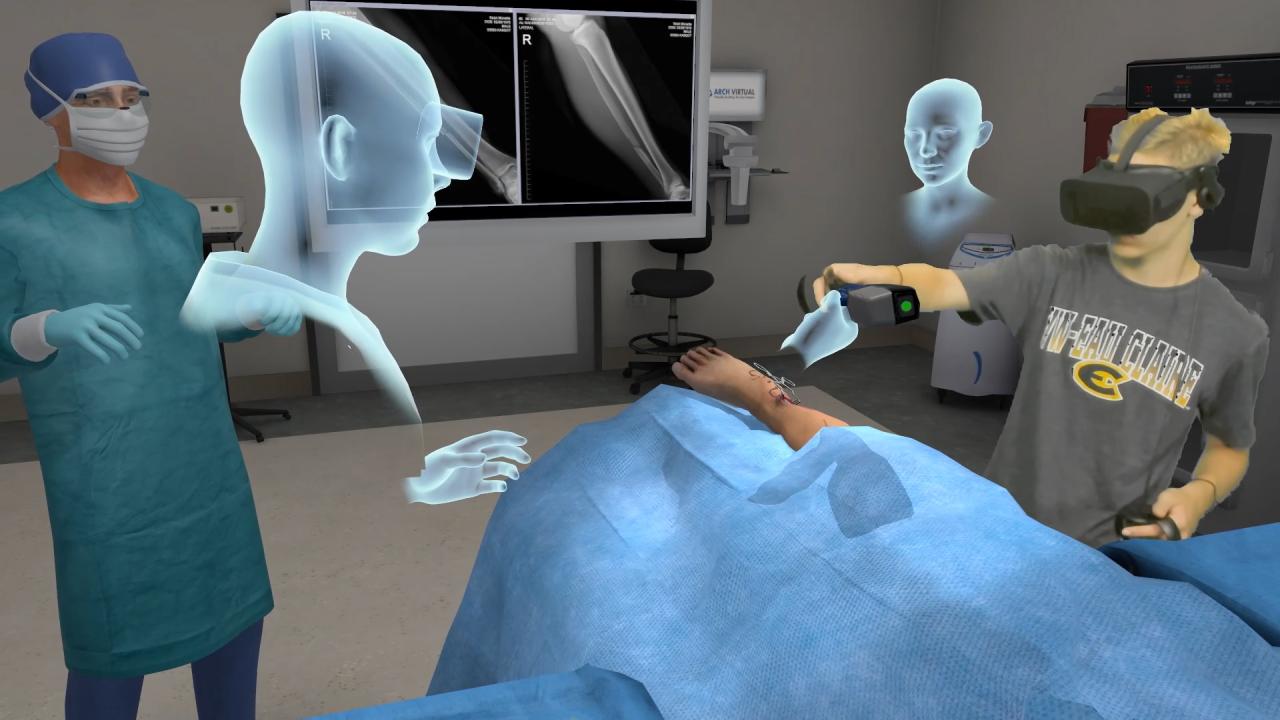Virtual Reality Training Simulations
Virtual reality training simulations offer a cutting-edge approach to learning, immersing individuals in realistic scenarios to enhance training outcomes and revolutionize the educational landscape.
From simulating complex medical procedures to providing hands-on experience in hazardous environments, virtual reality technology is reshaping the way industries approach training and skill development.
Introduction to Virtual Reality Training Simulations

Virtual reality training simulations involve the use of immersive technology to create realistic scenarios for training purposes. By putting users in a virtual environment, these simulations offer a safe space to practice skills and procedures without the risks associated with real-world training.
Virtual reality technology is used in training scenarios across various industries, including healthcare, aviation, military, and manufacturing. In healthcare, for example, surgeons can practice complex procedures in a virtual setting before performing them on actual patients. Similarly, pilots can undergo flight simulations to improve their skills without the need for expensive aircraft or putting lives at risk.
Examples of Industries Benefiting from Virtual Reality Training Simulations
- Healthcare: Virtual reality simulations are used for medical training, surgical procedures, and patient care scenarios.
- Aviation: Pilots use virtual reality for flight training, emergency simulations, and cockpit familiarization.
- Military: Soldiers undergo virtual reality training for combat scenarios, tactical exercises, and mission planning.
- Manufacturing: Workers practice operating machinery, safety protocols, and assembly processes in virtual environments.
Benefits of Virtual Reality Training Simulations

Virtual reality training simulations offer numerous advantages over traditional training methods, providing an innovative and immersive learning experience.
Enhanced Engagement and Retention
Virtual reality simulations allow learners to actively participate in realistic scenarios, leading to higher engagement levels compared to passive learning. The interactive nature of VR training also promotes better retention of information.
Safe Environment for Practice
VR training simulations enable users to practice skills and procedures in a safe and controlled environment without any real-world consequences. This allows for repeated practice and skill-building without risk.
Cost and Time Efficiency
By utilizing virtual reality for training, organizations can reduce costs associated with traditional training methods such as travel, materials, and instructor fees. Additionally, VR training can be conducted remotely, saving time and resources.
Personalized Learning Experience
Virtual reality simulations can be tailored to individual learning styles and skill levels, providing a personalized learning experience for each user. This customization leads to better outcomes and increased knowledge retention.
Real-time Feedback and Assessment
VR training simulations offer real-time feedback and assessment, allowing learners to track their progress and receive immediate guidance on areas for improvement. This instant feedback loop enhances the learning process.
Design and Development of Virtual Reality Training Simulations

Virtual reality training simulations require a meticulous design and development process to ensure effectiveness and engagement. Designers and developers play a crucial role in creating immersive and interactive training programs that meet the learning objectives.
Role of Designers and Developers
Designers are responsible for crafting the visual elements and user interface of the virtual reality training simulations. They focus on creating a realistic environment that simulates real-life scenarios to enhance the learning experience. Developers, on the other hand, work on the technical aspects of the simulation, ensuring that the software functions smoothly and provides a seamless user experience.
Technology and Software Used
The design and development of virtual reality training simulations rely on advanced technology and software tools. These include 3D modeling software such as Unity or Unreal Engine, which allow designers to create lifelike environments and objects. In addition, specialized VR hardware like Oculus Rift or HTC Vive is used to provide an immersive experience for trainees. Developers also utilize programming languages like C# or C++ to code the interactive elements of the simulation, making it responsive to user actions.
Implementation and Integration of Virtual Reality Training Simulations

Virtual reality training simulations are integrated into existing training programs by incorporating VR technology into the training curriculum. This involves creating immersive and interactive experiences that help trainees learn and practice skills in a virtual environment.
Best Practices for Implementing Virtual Reality Training Simulations
- Identify training needs: Assess the specific skills or knowledge that can be effectively trained using VR simulations.
- Customize content: Tailor the VR simulations to match the learning objectives and goals of the training program.
- Provide adequate support: Offer guidance and assistance to trainees to ensure they can navigate and benefit from the VR simulations effectively.
- Collect feedback: Gather feedback from trainees to continuously improve and enhance the VR training simulations.
- Integrate with existing systems: Ensure seamless integration with existing training platforms and systems for easy access and tracking of progress.
Successful Case Studies of Virtual Reality Training Simulations
One successful case study is Walmart’s use of VR training simulations for employee development. By immersing employees in real-life scenarios, Walmart has seen an improvement in employee performance and retention rates.
Another example is the medical field, where VR simulations are used to train surgeons on complex procedures in a safe and controlled environment. This has led to better surgical outcomes and reduced risks for patients.
Expert Answers
How are virtual reality training simulations different from traditional training methods?
Virtual reality training simulations provide a more immersive and engaging learning experience compared to traditional methods, allowing for hands-on practice in realistic scenarios.
Which industries benefit the most from virtual reality training simulations?
Industries such as healthcare, aerospace, defense, and manufacturing benefit significantly from virtual reality training simulations due to the need for hands-on training in complex environments.
What technology is used to develop virtual reality training simulations?
Virtual reality training simulations are developed using specialized software and hardware that create realistic environments and interactions for trainees.






